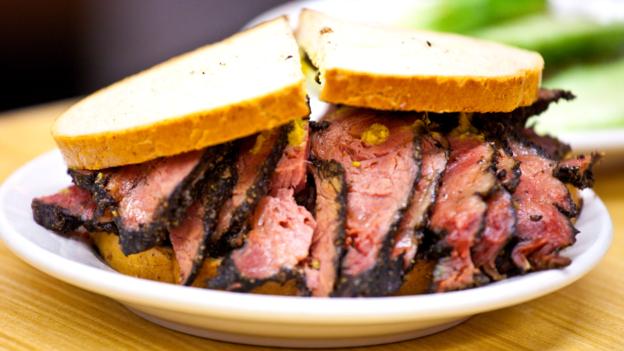The deli, they say, is dying. They’re not talking about the corner markets or bodegas that appear on nearly every New York block. They’re talking about the true New York City delicatessen: the brick and mortar expression of the American immigrant experience, the very culinary soul of the city. And unfortunately, where there used to be thousands, only a few remain.
More than 100 years ago, in the second half of the 19th Century, New York’s tenements were swelling with new arrivals from Europe. Many thousands of these immigrants were Jewish, escaping persecution in Eastern Europe and Russia, and most settled in New York’s chaotic Lower East Side. They carried with them their religious beliefs and culinary culture – and often very little else.
Their food was the food of the Eastern European peasantry – smoked sausages and cured meats, smoked cabbage and offal stews and dark bread, salted fish and boiled dumplings. Their dining habits were moulded through poverty, harsh winters and religious rules. Under kosher law, pork was forbidden, and dairy, fish and meat had to be strictly separated. When Jewish immigrants set up shop in New York, this separation was reflected in three types of businesses: dairies for the milk, appetizing stores for the fish and delicatessens for the meat.
Soon, delis were a hit and there was one on every corner of the Lower East Side. But since World War II ended, the neighbourhood became crime-riddled, later turned into a hotbed of intensive gentrification and finally settled as the hip warren of trendy eateries it is today, all the while shedding small local business like the deli. Now in the old neighbourhood, only one old-school deli is left: Katz's Delicatessen on the corner of Houston and Ludlow.
Having survived rent hikes and employing shrewd business tactics, the 128-year old deli is perennially packed; Katz’s sells more than 10,000 pounds of pastrami a week, and more than 12,000 hot dogs. Their signature sandwich – thick hand-cut slices of pastrami served on rye bread with mustard – is justifiably world famous.
Today this final holdout of the old ways is in the hands of Jake Dell, a 28-year-old self-described “Prince of Pastrami” and third-generation deli man, who took over from his uncle and parents three years ago. With his family, Dell has watched other delicatessens in the neighbourhood shutter, falling victim to the same three issues that have doomed most delis the world over.
The first is economic – running a deli is laughably expensive. For the most part, delis depend on one ingredient, beef – corned or pastrami’d, put in a hot dog or, in the case of tongue, pickled. When the price of beef goes up, other restaurants can change around their menus, push salads or appetizers, but no one is going to line up around the block at a deli for a cup of chicken soup or a plate of latkes.
The second reason so many delis close is cultural. The deli is a mirror of the American Jewish immigrant experience, and that experience has changed.
“You’re not going to be cutting meat for the rest of your life. I’m telling you my son, you’re going to go be a doctor, you’re going to be a lawyer,” said Dell, imitating a Jewish grandfather. “Maybe it’s not the first generation, maybe it’s not the second, but after a while, you start to see delis disappear because there’s no one left to take over.”
The third reason is changing trends. Today’s dining landscape is health-conscious and vegetable-forward. Delis serve fatty meat and lots of it. Vegetable options at a traditional deli are mostly limited to fried potatoes and pickles, and purists wouldn’t have it any other way.
According to David Sax who wrote Save the Deli: In Search of Perfect Pastrami, Crusty Rye, and the Heart of Jewish Delicatessen, 1930s New York was home to three or four thousand delis. Today, there are less than two dozen.
With that in mind, Dell’s responsibility to Katz’s is weighty and two-fold: preserve the deli tradition in the face of a changing world, and heed the writing on the wall. In other words, innovate or die.
In a way, Dell is the perfect man for the job. He is steeped in the old ways, but also a young, modern entrepreneur. Where his parents got their business experience behind the meat counter, Dell went to New York University’s Stern School of Business and got his MBA.
Alongside expanding the restaurant’s popular catering service, revamping its website and modernizing its shipping, for the first time in Katz’s history, Dell is breaking ground on a new location, a takeout-only restaurant in downtown Brooklyn.
However, Dell is the first to admit that a successful Katz’s delicatessen alone will not save the deli in New York City. For that, the deli has to come into the 21st Century and meet the needs of a new modern clientele. It needs people like Noah Bernamoff and his wife, Rae.
The Bernamoffs – and their partner Max Levine – opened the Mile End Deli six years ago. Instead of Manhattan’s Lower East Side, they put it in the hipster enclave of Boerum Hill, Brooklyn. “Our goal was to create a deli that reflected our current values,” Bernamoff said, “not necessarily the values of our parents.”
They started by looking back to the deli’s 19th Century beginnings. The archetypal American deli – with cafeteria lighting and old men angrily returning soup – is an invention of the 1950s. The deli that interested Bernamoff was the deli of the first few generations of immigrants that arrived here, bringing the focus back on the product. His pastrami is dry cured, not wet brined – and is steamed and cut thick and by hand, not portioned and boiled – like many other places. The result is a thick slice of boldly beefy, well-spiced and almost botanical pastrami that crumbles in your mouth but holds up when piled high on rye.
“All these steps are traditional and in line with extra-traditional deli,” he explained. “What I often say, is it goes back beyond the deli we now consider to be old school deli.”
While the product may be “old school” through and through, Bernamoff is fully aware of the new generation of younger, plugged-in, food-obsessed consumers. He carefully sources all of his products, using all-natural Black Angus beef without antibiotics or hormones. Mile End is bright and airy with reggae coming through the speakers, and the menu has a few modern crowd pleasers like a warm vegetable salad with yogurt and mint, and Montreal-inspired smoked meat poutine.
If the Bernamoffs are looking back, then Will Horowitz is looking way, way back. While Bernamoff harkens back to the original American delis, Horowitz is interested in the age-old techniques from Eastern Europe that underpinned them. Horowitz, who – with his sister Julie – opened Harry & Ida’s in 2015 in the East Village, is delicatessen’s mad scientist. In its small kitchen and cellar, there are ribs in the smoker, venison dry-aging in a closet, rows of pickling barrels, trays of salted fish, jars of tiny oysters in oil and an aquarium of eels.
“If you look at the past 80 years, we have this tradition, but what about the last 150 years or 200 years?” he said. “What is traditional pastrami? The original pastrami in Southern Romania or Hungary was probably more cured and smoked goose breast than it was beef.”
Horowitz may depend on ancient techniques but what he makes is boldly, radically modern. Pastrami at Harry & Ida’s isn’t served on rye bread but on a sandwich roll. The aromatic, old-world tang of the sandwich comes instead from caraway seeds and rye berries in an accompanying buttermilk slaw. The mustard – A. Bauer's Mustard – is as traditional as it gets, but they take it on a trip through Spain, hitting it with preserved Meyer lemon and brined white anchovies.
The pastrami itself is cut the thickest of all, and spends more time in the smoker than most, a nod to Horowitz’s love of Texas barbeque. Finally, the sandwich is finished with a handful of fresh dill, an old-country ingredient but a flourish he picked up from South East Asia.
The sandwich is wholly new, but in its way is absolutely true to the soul of delicatessen: a reflection of the Jewish immigrant experience. Now in the fourth or fifth generation, that experience is sophisticated, global, aware of the past and alive with possibilities.



